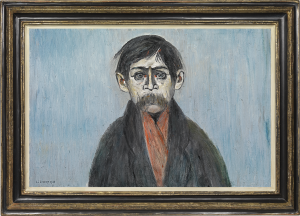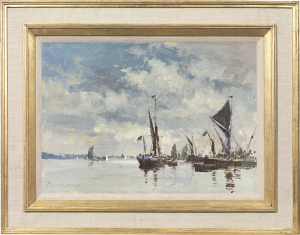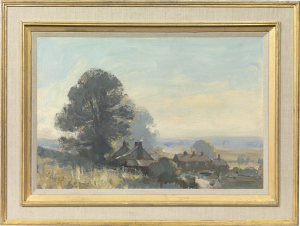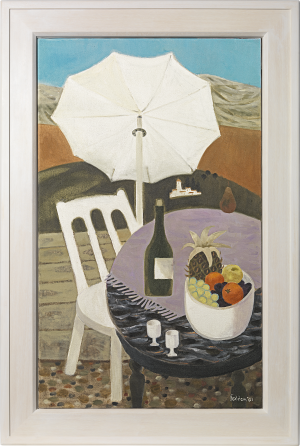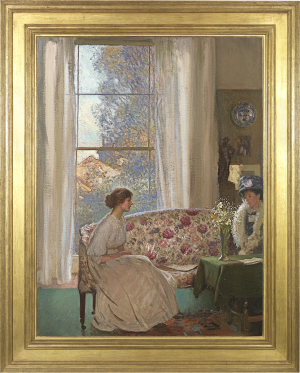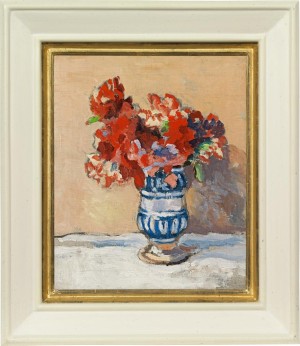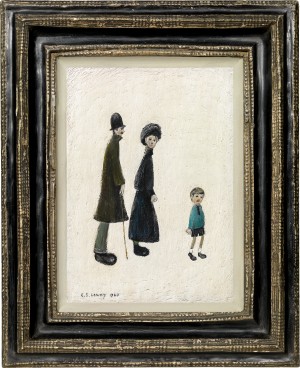Harold Knight
Land's End
Oil on canvas: 24 x 20 (in) / 61 x 50.8 (cm)
Signed lower left: Harold Knight
This artwork is for sale.
Please contact us on: +44 (0)20 7493 3939.
Email us
HAROLD KNIGHT RA ROI RP RWA
Nottingham 1874 - 1961 Colwall, Herefordshire
Ref: CB 164
Land’s End
Signed lower left: Harold Knight
Oil on canvas: 24 x 20 in / 61 x 50.8 cm
Provenance:
The artist, given to his niece, then by descent
Exhibited:
Possibly London, Royal Academy of Arts, Summer Exhibition, 5th May-26th August 1951, no.24, as The Land’s End on a September Morning
London, Upper Grosvenor Galleries, Dame Laura Knight RA: Water Colours and Drawings. Harold Knight RA: Oil Paintings, 18th May-2nd June 1967, either no.72 or 73, as Land’s End in September or Land’s End
A quieter foil to his ebullient wife Laura, Harold Knight was an equally fine painter, renowned for his portraits and interiors. Born in Nottingham, the son of an architect, Knight studied at the Nottingham School of Art, where he met Laura Johnson (1877-1970), before travelling to Paris in 1894 to continue his training at the Académie Julian with Benjamin Constant and Jean-Paul Laurens. The couple married in 1903, and after living in Staithes and travelling across the Netherlands, the Knights moved to Cornwall in 1907. Both artists became part of the Newlyn community and, despite moving to London in 1919, they regularly returned to paint Cornish seascapes throughout their careers. By 1937, Harold Knight was elected a member of the Royal Academy, and the two artists became the first married Royal Academicians. Land’s End is an enchanting example of Harold Knight’s seascapes. He skilfully juxtaposes the meticulous depiction of the undulating coast line and rocky, granite cliffs with the soft blue tones of the sea and white crests of the waves. His striking use of colour was recognised by contemporaries, as a 1921 article in The Studio notes that Harold Knight ‘has devoted himself to the study of the effect of daylight, both in the open and indoors and he has mastered the difficulties created by the subtle variations of tone and colour due to the pervading light. This enables him to introduce into his pictures delicate and beautiful tone-gradations without sacrificing the brilliancy and freshness of his colour-schemes.’ (Ernest G. Halton, ‘Foreword’, Modern Paintings Number One: The Work of Laura and Harold Knight, The Studio Ltd, London, 1921, p.5). Despite their shared subject matter, the couple approached their work in different ways. This is described by Charles Wheeler in the foreword to their joint exhibition of 1967, ‘In Laura’s attack there is a compelling immediacy. One feels her pencil is itching her hand to get to the paper... Harold would seem to stand back awhile and think. With great care he would then put into operation his most restrained modus operandi’ (Dame Laura Knight, Harold Knight, Upper Grosvenor Gallery, 1967). A photograph of Laura Knight standing in front of the present work was taken at their joint exhibition, perhaps showing its personal significance. This painting will be included in the forthcoming catalogue raisonné of the work of Dame Laura Knight currently being prepared by R. John Croft F.C.A., the artist’s great-nephew.
Harold Knight, A view of Mousehole Harold Knight, St Ives Bay, Cornwall
Oil on canvas: 48.5 x 44 cm Oil on canvas: 30.5 x 35.6 cm
Penlee House Gallery & Museum Nottingham City Museums & Galleries











